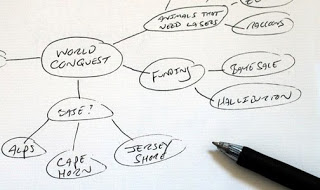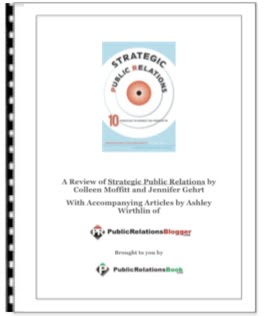________________________________________________________________________
From a discussion earlier this week on brainstorming, I thought it important to share the relevance and uses of brainstorming in PR (and other business) planning.

Public Relations & Business: The Importance of Brainstorming
________________________________________
From a discussion earlier this week on brainstorming, I thought it important to share the relevance and uses of brainstorming in PR (and other business) planning.First, a definition of brainstorming: a group creativity technique designed to generate ideas and solutions for a problem.
While there may be some issues with brainstorming (see below), it is a great tool to use as a company (or even just a team of two) to get together to share ideas and bounce them of of each other. Another benefit of brainstorming is the ability to see more clearly why an idea may not be feasible or why an idea is better than first anticipated. With many minds thinking about a solution for accomplishing a company goal, a solution may be found more easily and quickly. Try doing a S.W.O.T. analysis to really evaluate your situation and what is feasible as a solution.
There is some controversy about this technique, mostly that it will not help the solution process and will not create a large number of ideas, as it is intended to do. Regardless of the number of ideas presented, it can help to get creative ideas flowing. There are a few real problems with brainstorming, one being "groupthink". When groupthink happens, the group encourages itself to support a single idea instead of generating new, unique ideas because the single idea sounded like a good solution. This has been seen in studies, and can be linked to psychological aspects of a group and the desire to belong. Groupthink is like a wildfire that catches wind and affects the group as a whole.
Another example of a brainstorming drawback could be "social loafing". This is when the members of a group put less effort into a project because they are working in a group rather than individually. Additionally, it can be defined as the occurrence of "people making less effort to achieve a goal when they work in a group than when they work alone. This is seen as one of the main reasons groups are sometimes less productive than the combined performance of their members working as individuals." (Source)

A good way to alleviate the issues of "groupthink" or "social loafing"
is to ask members of your group to brainstorm individually with tools such as mind mapping
where ideas are started with a single word or phrase written down. The individual (or team/group, if this is used collectively) then
branches ideas off of this central theme to map
their thinking and train of thought. These maps can then be brought to the brainstorming session when the group is gathered in the hopes of diminishing the problems of brainstorming. Ask the group to share ideas and write them on a board for the team to see, without judging them or assigning them worth. After all the ideas have been shared, evaluate which ones may be best suited for the problem at hand.
Despite a few unavoidable aspects and characteristics of a group, brainstorming, like crowdsourcing, can help to get the best ideas on the table by tapping into a larger resource of knowledge than one brain can offer. Keep the environment open, welcoming, and encourage participants to share their ideas to really get the most out of the session.
Do you have examples of brainstorming techniques that have (or have not) worked for you? Click on this post title and leave a comment!
Popular choices
- Non Gamstop Casino
- Mejores Salas De Póker
- Non Gamstop Casinos
- Siti Casino Online Non Aams
- Migliori Siti Casino Online
- UK Online Casinos Not On Gamstop
- Non Gamstop Casino Sites UK
- Non Gamstop Casino Sites UK
- UK Casino Not On Gamstop
- Casinos Not On Gamstop
- Online Casino
- オンラインカジノ
- UK Casino Not On Gamstop
- UK Casino Not On Gamstop
- Reputable Non Gamstop Casinos
- Casinos Not On Gamstop
- Best Non Gamstop Casinos
- Non Gamstop Casino
- Casinos Not On Gamstop
- Slots Not On Gamstop
- Non Gamstop Casino
- Casino Non Aams
- Casinos Not On Gamstop
- Betting Sites Not On Gamstop
- Casino Online Italia
Subscribe to:
Post Comments (Atom)






Comments (0)
Post a Comment